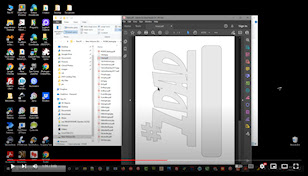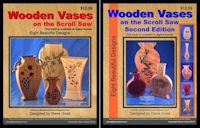You can fill the Halloween box up with candy and have it sitting on your front porch for all the little gobline that show up. The box is not too large. It is 8" wide and 6.5" tall so you may consider making a larger box if you expect a lot of goblins to show up.
The Christmas Tree Candle Holder pattern call for 1/4" thick wood. You will also need a 1/4" diameter wooden dowel. It will hold a candle up to 3.75" diameter. Please use and electric candle for safe use.
One of most common questions I receive is this. "What scroll saw blades should I purchase? Why are there so many choices?" As you might imagine, I have almost every type and brand of scroll saw blades made. So what do I use? I am a minimalist when it comes to blade choice. Unless I am cutting a special material or a pattern that requires a certain blade I use a #5 scroll reverse 90% of the time. If the wood I am cutting is very hard or thick I will use a #7 scroll reverse blade. I cannot remember a time when I used a larger blade than a #7. If I am cutting a large portrait style pattern I will use a spiral blade but to be honest I am not very good with spiral blades. For me they are more difficult to control but sometimes they come in handy.
There are time when the material you cut needs a specialty blade. Acrylic, thin metal, Corian, some less expensice plywood oftern need blade designind for those options.
Choosing the Best Scroll Saw Blade for Your Material
The scroll saw is a versatile tool, perfect for intricate cuts, delicate curves, and detailed designs. However, its true potential is unlocked by selecting the correct blade for the material you're working with. Using the wrong blade can lead to splintering, rough edges, blade breakage, and a frustrating experience. This guide will help you navigate the world of scroll saw blades for common materials like acrylic, thin metal, and Corian.
Understanding Scroll Saw Blades
Before diving into specific materials, let's briefly review scroll saw blade characteristics:
TPI (Teeth Per Inch): This is perhaps the most crucial factor. Higher TPI blades create finer cuts and are generally better for delicate materials and intricate details. Lower TPI blades are for faster cuts and thicker materials, but can leave a rougher finish.
Blade Width: Wider blades are more rigid and better for straight cuts and less intricate curves. Narrower blades allow for tighter turns and more detailed work.
Blade Thickness: Thicker blades are more durable and less prone to breaking, but can be harder to maneuver for delicate cuts. Thinner blades are essential for intricate work.
Tooth Style:
Standard Tooth: The most common, with teeth evenly spaced.
Skip Tooth: Teeth have a space between them, allowing for better chip removal and reducing heat, ideal for plastics.
Double Skip Tooth: Similar to skip tooth but with even more space, good for even faster chip removal.
Reverse Tooth: A few teeth at the bottom of the blade point upwards, helping to reduce tear-out on the underside of the workpiece.
Crown Tooth (2-Way Cut): Teeth cut on both the up and down stroke, resulting in very smooth cuts with minimal tear-out.
Spiral Blades: These blades have teeth all around the shaft, allowing you to cut in any direction without rotating the workpiece. Great for internal cuts and intricate designs, but can produce a wider kerf.
Blades for Acrylic
Acrylic (Plexiglas) is a beautiful material for scroll saw projects, but it requires a careful approach to prevent melting, chipping, and cloudy edges. The key is to generate as little heat as possible.
TPI: Aim for a higher TPI, typically #5 to #7 (12-18 TPI). This will ensure a smoother cut and reduce chipping.
Tooth Style: Skip-tooth or double skip-tooth blades are highly recommended. The larger gullets between the teeth allow for excellent chip removal, preventing the acrylic from melting and re-welding to itself (a common issue with standard teeth). Reverse-tooth blades can also be beneficial to minimize tear-out on the bottom surface.
Blade Size: Use the narrowest blade suitable for your design to allow for tight curves.
Speed: Run your scroll saw at a slower speed to further reduce heat buildup.
Technique: Cut slowly and avoid forcing the material. Allow the blade to do the work. Consider cooling the blade with compressed air if you're experiencing melting.
Blades for Thin Metal (e.g., Brass, Copper, Aluminum)
Cutting thin metals on a scroll saw is entirely possible, but again, blade choice is paramount to avoid excessive wear, breakage, and rough edges.
TPI: You'll generally want a higher TPI for metals, usually in the range of #5 to #9 (12-25 TPI). The thinner the metal, the higher the TPI you should consider. The goal is to have at least two teeth in contact with the material at all times to prevent snagging and stripping teeth.
Blade Material: While carbon steel blades can work for softer metals like aluminum, hardened steel or bimetal blades will last significantly longer when cutting brass or copper.
Metal Cutting Blades: Look specifically for blades marketed for metal cutting. They often have specific tooth geometries designed for durability.
Tooth Style: Standard tooth blades can work, but some scroll saw users prefer skip-tooth for softer metals to aid in chip removal.
Speed: Use a slower to medium speed. Too fast can generate excessive heat and wear down the blade quickly.
Lubrication: Applying a small amount of cutting wax or light oil to the metal before and during cutting can significantly improve blade life and cut quality.
Technique: Cut steadily and avoid forcing the blade. Let the blade do the work.
Blades for Corian (Solid Surface Material)
Corian and similar solid surface materials (like Avonite, Staron) are often used for countertops and decorative items. They cut beautifully on a scroll saw with the right setup, producing a very smooth edge.
TPI: A medium to high TPI blade, around #5 to #7 (12-18 TPI), generally works well. This provides a clean cut without chipping.
Tooth Style: Skip-tooth or reverse-tooth blades are excellent choices for Corian. Skip-tooth blades help with chip removal, and reverse-tooth blades reduce any potential fuzzing or tear-out on the underside, leaving a smooth finish on both sides. Crown tooth (2-way cut) blades can also produce exceptionally smooth edges.
Blade Size: Choose a blade width appropriate for the curves in your design.
Speed: You can generally use a medium to fast speed with Corian, as it doesn't tend to melt like acrylic. Experiment to find what works best for your specific material and blade.
Technique: Cut steadily and allow the blade to do the work. Corian cuts relatively easily, but forcing it can lead to blade deflection or breakage.
Dust Collection: Corian produces a fine, powdery dust. Ensure you have good dust collection or work in a well-ventilated area and wear a respirator.
General Tips for All Materials:
Blade Tension: Always ensure your blade has proper tension. A blade that's too loose will wander and break easily; too tight can also lead to breakage. A good test is to pluck the blade – it should produce a clear musical tone.
Practice: If you're new to a material or blade type, practice on scrap pieces first.
Safety First: Always wear appropriate eye protection and ensure your work area is clean and well-lit.
Blade Condition: Replace blades as soon as they show signs of dullness or damage. A dull blade causes more heat, rougher cuts, and more frustration.

Halloween Basket Pattern
Email Newsletter Readers: Remember that the Newsletter is just a copy of the daily blog post. To see the post in its proper formatting click this link. If you ever misplace a pattern or any item you see here you can always find it on the blog. Everything stays on the blog forever.
Every Scrollsaw Workshop Pattern from 2007-2024 on USB drive, or Instant Download. Over 4,900 Patterns!
Purchase the entire Scrollsaw Workshop pattern catalog for offline access.You will never run out of fun patterns to cut.
Two delivery options.
After payment, you will receive an email with the download link. This is a large file. You should not attempt to download it on a tablet or smartphone. It is a compressed file that will need to be extracted to your hard drive. Basic computer skills are necessary to extract the file.
Click this link to order the USB Drive
The USB drive contains all the Scrollsaw Workshop Patterns. The drive is $25 plus shipping and handling. Now, with the new distributor the drive ships to the US and many other countries. The shipping can get expensive to some international locations, so the Instant download option above is probably more desirable.
My two "Wooden Vases on the Scroll Saw" books make it easy.
The books are $12 each and are available for instant download after purchase. Click for a Video Demonstration.
My Sponsors:
Support the businesses that support our community.
Home of Pegas scroll saw blades.



.gif)

.gif)
.gif)









